“The view from Ortolithon is majestic. We can see Holm oaks, blackberries, carob trees covered in honeysuckle, cypresses, olive trees, mastics, and laburnum [= Cytisus laburnum or goldregen (golden rain)]. Myrtle, broom and euphorbias also grow in this poor soil.
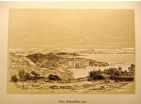 The place is extremely wild, and one happily can stop here, listening to the sea break on the nearby rocks and entering into an elemental state of mind.
The place is extremely wild, and one happily can stop here, listening to the sea break on the nearby rocks and entering into an elemental state of mind.
“The road leaves from Agios Spiridion in Mizalatika towards Romiti along a valley with short terraces covered in pretty olive trees and a lot of ferns. To the left is a small olive grove where –they say– the spring starts. The top of the walls are covered in thorny bushes lining the paved road. The latter also has steps which lead down to a water deposit surrounded by pretty stone walls. We find a double wall next to a fountain with a pretty square deposit underneath and two strong pointed arches on the top part. The water comes out from both, especially the one on the right. The excess water drips to the sea above the cliffs on the coast.

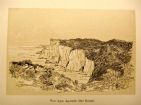
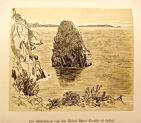 A path with steps descends from the hermit’s home to slopes on which cypresses and a few olive trees grow closed in by dry walls. It heads towards Achai, passing above the slopes of Trafos Playas, where some heather and myrtle grow. Up above, overlooking the sea, was one of the four crosses which protected Paxos from the four winds. The peak is called Sto Angali, and there is a precious view of Ortholithon from here. The view is wild from here above the sloped walls, the sea and the faraway islands.
A path with steps descends from the hermit’s home to slopes on which cypresses and a few olive trees grow closed in by dry walls. It heads towards Achai, passing above the slopes of Trafos Playas, where some heather and myrtle grow. Up above, overlooking the sea, was one of the four crosses which protected Paxos from the four winds. The peak is called Sto Angali, and there is a precious view of Ortholithon from here. The view is wild from here above the sloped walls, the sea and the faraway islands.
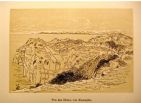 Above it all, where some cypresses grow, is Agios Nikolaos Church. Looking down you can see the windmill in Lakka. The terraces with olive trees are well cared for, some connected by steps. From here everything belongs to Kastanjida ( Kastanitha), and you can see the Agios Apostolis Church. The path descends and passes by a cistern. The view of Corfu is marvellous as is the coast of Albania to the left of Point Lurida.”
Above it all, where some cypresses grow, is Agios Nikolaos Church. Looking down you can see the windmill in Lakka. The terraces with olive trees are well cared for, some connected by steps. From here everything belongs to Kastanjida ( Kastanitha), and you can see the Agios Apostolis Church. The path descends and passes by a cistern. The view of Corfu is marvellous as is the coast of Albania to the left of Point Lurida.”
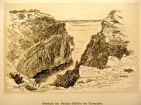 Kastanjida ( Kastanitha) is famous, as we mentioned in the general section for its quarries. This is where the fine limestone comes from, consisting of clay, numerous forams and more compact lime rich in orbitoides but poorer in forams and nummulites. Here we see a view above the Phokas caves.”
Kastanjida ( Kastanitha) is famous, as we mentioned in the general section for its quarries. This is where the fine limestone comes from, consisting of clay, numerous forams and more compact lime rich in orbitoides but poorer in forams and nummulites. Here we see a view above the Phokas caves.”





























